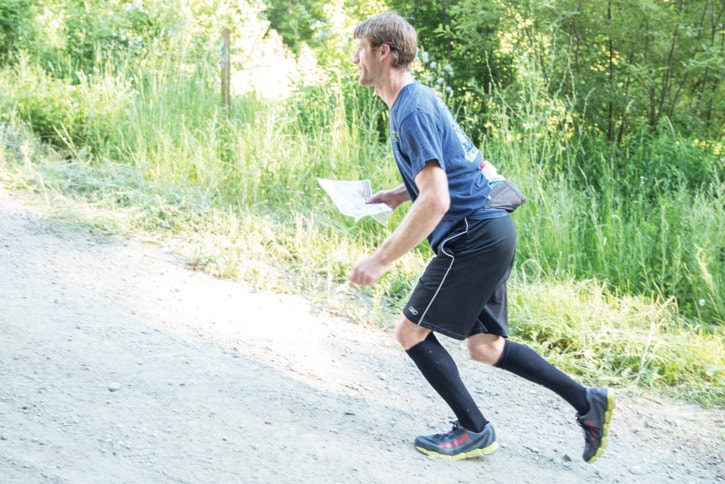Typically to get from one point to another the quickest way is in a straight line, but that is not the case when it comes to the sport of orienteering.
Both mental and physical aspects play a vital role in the sport, making it the ultimate scavenger hunt, while trying to reach a series of checkpoints as quickly as possible.
An orienteerer has to be able to run or jog at a steady pace while following the guidance of a detailed map and compass, often making split second decisions.
Over the past four weeks, the Sage Orienteering and Rogaining Club has hosted a series of orienteering training exercises and races in the Salmon Arm area.
“Sage is based out of Kamloops and we found that our numbers from Salmon Arm were growing, so we thought it would be a great idea to offer some new courses in the area,” said event director Abbi May.
The May family is by all accounts an orienteering family.
Dad, Brian May is the reigning North American middle distance champion, and has brought his entire family into the sport, including his children Rachel and Trond, as well as his wife, Abbi.
“As a kid I always loved running in the forest and following a map, and finding the checkpoints is always a little treat. It’s like a big treasure hunt,” said Brian.
In July, the May family will cross the pond to participate in the Junior World Orienteering Championships, in Rauland, Norway and the World Masters Orienteering Championships in Gothenburg, Sweden.
Competing in the 15,000 strong field at the masters in Sweden will only be a warm up for Brian.
A week later, he will compete in the sport’s most prestigious event, the World Orienteering Championships, which will be held in the wild and untamed Scottish Highlands near Inverness.
“This will be my fifth world championships and I am just as eager as the first time I competed. The level of competition is enormous,” said Brian.
“I won’t be at the top end of the competition, but it will still be a great experience.”
The week-long event, which starts on July 31, will feature the sport’s three distances: sprint, medium and long tracks, and also include a relay and a sprint relay.
A sprint event is typically run in an urban or semi-urban environment, such as a park and usually lasts around 15 minutes and can vary in distance from one to three kilometres.
“A middle-class event is a very technical race. It’s usually run in a dense forest and there are cliffs, boulders and gullies and will range in time from 40 to 50 minutes,” said Abbi.
The long event is a test of endurance and requires thoughtful route planning.
A typical long event will last 60 to 90 minutes and traverse up to 12km over a similar terrain as the middle-distance event.
The relay events consist of a three-person team, where each member runs a different section of trail.
At the start of each race, runners are provided with a topographic map that details water, rock features, vegetation boundaries and shows where each individual checkpoint is.
It is up to the runner to decide what they feel the fastest way to get to each control point is.
Participants are also given a small electronic memory stick which they “tap” at each checkpoint logging the time it takes to get to each one.
A missed control point will result in a disqualification.
“At the end of the race it is always fun to compare times and route choices with fellow racers,” said Abbi with a smile.
“Each checkpoint is placed on a landmark, like a tree, boulder or fork in a trail. It won’t be in an obscure place or middle of a field.”
When starting out the easiest way to pick up the sport is to always orient the map to the terrain, turning the map when you turn and remembering where north is.
In individual events each runner is started in two or three minute split intervals.
“The good thing about this sport is that you don’t have to run flat out all the time. You can stop and look at your map and pretend you’re tired,” joked Jesse Heckrodt.
Brian says the more comfortable you can become with a map and compass the better off you will be to make split-second decisions about which path to take.
“The physical aspect of running will take care of itself, that’s the easy part to train for. The more time you spend with a map and compass the better off you’ll be.”
Abbi says the sport is the best way to see the country, spend time outdoors and have the whole family take part.
More than 40 orienteerers have taken to the sport each of the last four weeks of the spring series in Salmon Arm.
The family-friendly events are tailored to the various age groups and skill levels with distances and terrain made suitable to each group.
“This series has been a great boost to the sport in the area and helped to increase our presence, especially in our first year here” said Brian.
Next Monday will be the final event of the spring series at South Canoe at 5:30 p.m.
To register for the event visit Sage’s website, sage.whyjustrun.ca.
“The terrain in South Canoe has open forest, undergrowth, thick forest, and creeks, which makes it challenging and fun,” said Abbi.
